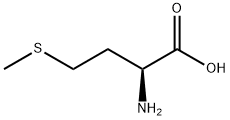Selenomethionine , 98+% , 1464-42-2
Synonym(s):
(S)-2-Amino-4-(methylseleno)butyric acid;Seleno-DL -methionine;Seleno-L -methionine
CAS NO.:1464-42-2
Empirical Formula: C5H11NO2Se
Molecular Weight: 196.11
MDL number: MFCD00063089
EINECS: 215-977-0
| Pack Size | Price | Stock | Quantity |
| 100mg | RMB477.60 | In Stock |
|
| others | Enquire |
PRODUCT Properties
| Melting point: | 267-269 °C |
| Boiling point: | 320.8±37.0 °C(Predicted) |
| storage temp. | -20°C |
| solubility | almost transparency in 1mol/L HCl |
| pka | 2.26±0.10(Predicted) |
| form | solid |
| color | White to Almost white |
| Water Solubility | soluble |
| Merck | 14,8441 |
| BRN | 1758204 |
| NIST Chemistry Reference | Butanoic acid, 2-amino-4-(methylseleno)-(1464-42-2) |
| EPA Substance Registry System | Butanoic acid, 2-amino-4-(methylseleno)- (1464-42-2) |
Description and Uses
Selenomethionine is the major form of selenium in plant foods. Selenomethionine is identical to methionine, except that selenium replaces the sulfur atom. The selenium consumed as selenocysteine is broken down to form alanine and hydrogen selenide (H2Se). The breakdown pathway of selenomethion- ine is not clear. Although selenium does not occur to a great extent as selenite in foods, selenite is readily used as a source of the element by humans and animals. Selenium also occurs as selenate in foods such as beet leaves, garlic, and cabbage.
DL-Selenomethionine is a selenium (Se) analogue of methionine in which sulfur is replaced with the trace element selenium. Selenomethionine (SeMet) can incorporate into proteins in place of methionine with no effects on protein structure and function, providing a mechanism for reversible Se storage in organs and tissues. Free selenium is incorporated into selenocysteine, an amino acid found in more than thirty selenoproteins including the glutathione peroxidases (GPx) enzymes, thioredoxin reductase (TR) and the iodothyronine deiodinase enzymes.
contrast agent
Safety
| Symbol(GHS) |    GHS06,GHS08,GHS09 |
| Signal word | Danger |
| Hazard statements | H301+H331-H373-H410 |
| Precautionary statements | P260-P264-P273-P301+P310-P304+P340+P311-P314 |
| Hazard Codes | T,N |
| Risk Statements | 23/25-33-50/53 |
| Safety Statements | 20/21-28-45-60-61 |
| RIDADR | UN 3283 |
| WGK Germany | 3 |
| RTECS | ES7110000 |
| HazardClass | 6.1 |
| PackingGroup | III |
| HS Code | 2931909000 |
| Hazardous Substances Data | 1464-42-2(Hazardous Substances Data) |



